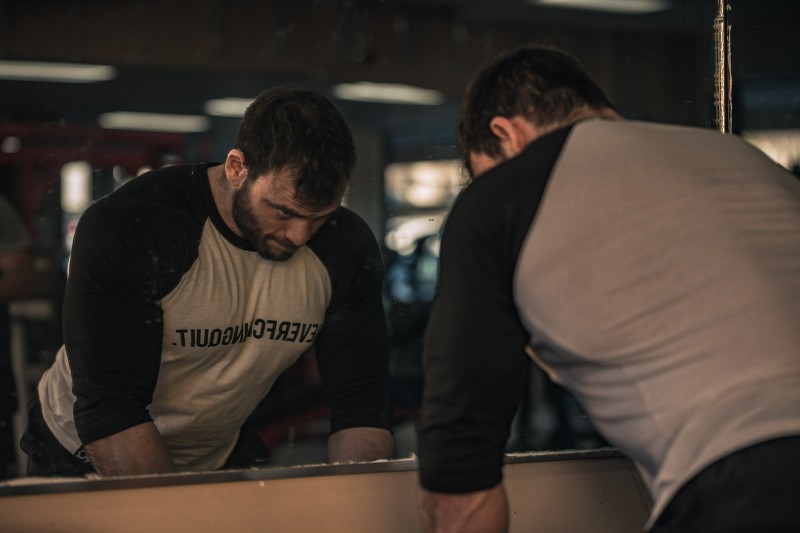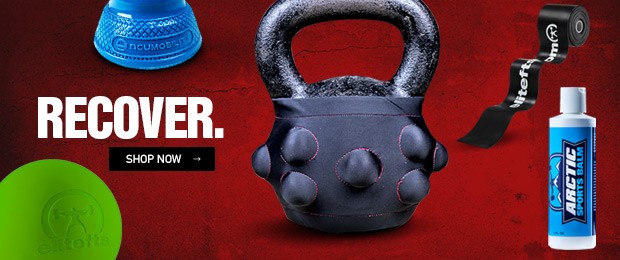
I was just two weeks into my meet prep when I felt it during a set of bench: that sickening sensation of a pulled muscle. Oh, shit. Immediately, my brain started spinning. How bad was it? How long would it take me to recover? How was this going to affect my prep? Fortunately, my injury was just a very minor pec strain and, physically, I was back to full speed within a week. But it took me a little longer than that to regain the mental confidence to bench all-out again. If you’ve ever been injured, you’ve probably experienced something similar. Oftentimes, the mental aspects of recovering from an injury are more daunting than the physical ones.
I’ve already written about how a strong mindset will help you to heal any injury overnight, but now I want to get more into the details: day by day, week by week, how you can deal with the quickly-changing and very challenging aspects of getting over an injury.
Your “Oh, Shit” Moment
Usually, the head games start from the instant you’re injured with the thoughts that begin running through your mind. “Oh, shit,” right? Even if you don’t experience pain, or even really know what happened, you can still immediately tell that something’s not right. Researchers have actually done a lot of work on the experience of injury, and oftentimes, athletes frame injuries in terms that reflect more of a mental trauma than a physical one. Check out some of these descriptions of injuries in elite athletes:
- “Because of the injury, I’m really a no one.”
- “[I was in] a state of denial.”
- “I just felt inadequate.”
- “I felt broken.”
Now, a big part of this framing comes from the fact that as athletes, we accept physical pain as part of the game. We don’t shy away from it during a set of heavy squats, so it doesn’t seem all that out of place in other aspects of sport. But the mental side is a little different. If you look at those responses above, they’re all kind of getting at the same thing: vulnerability. Vulnerability is actually a great thing, and it can make you a better lifter once you learn to use it and not run from it. But in everyday life, we’re extremely conditioned to run away at the first sign of vulnerability. It’s kind of ironic: we’re supposed to act invulnerable to everything, which makes vulnerability a huge weakness.
Dr. Brene Brown is a researcher who earned her PhD from The University of Texas, and her research focuses on vulnerability. Dr. Brown explains that real courage comes from the willingness to feel vulnerable — not to enjoy it, but to recognize that it might feel uncomfortable and feel it anyway. That kind of courage allows us to take risks, push ourselves outside of our comfort zone, and, ultimately, to live, learn, and pass on. And after all, that’s why y’all are here on elitefts.com, right?
Vulnerability and Injuries
Of course, when it comes to injuries, being willing to feel vulnerable is easier said than done, because nobody wants to get hurt — and, if you’re already hurt, you don’t want to get hurt worse. The really lousy thing is that if you want to heal up, eventually you’re going to have to take risks, at least small ones. Back in the 1800s, the cure for pretty much any physical injury was bedrest, and that just made things worse. You've got to use your body if you want it to get stronger and, at first, that’s going to be really uncomfortable and you’re going to feel really vulnerable. The secret is to find the sweet spot. Physically, that means finding ways to safely and effectively train the injured area. Mentally, it means learning to acknowledge the fear of injury but remembering you’re actually not broken; you’re just vulnerable. The faster you’re able to find the sweet spot, the sooner you’ll get back in the game.
So, how do you do that? Well, there’s never a right answer, but here’s what I do. Keep in mind, these are strategies for returning to lifting after you’ve been medically cleared — not for the acute phases of an injury.
Use High Reps — Like, Really High
One of the hardest parts of rehab is working back up into heavy weights. When you’re starting out with the rehab process, you’ll probably be using very light resistance—maybe only dumbbells and machines—and so you won’t have to deal with the crushing sensation that can come from handling heavier loads. That crushing sensation can be unnerving even when you’re feeling 100%, so it’s no surprise that it can really mess with your head during a comeback. The very best way to overcome this involves using high reps. When you’re training high reps, you can work your muscles really hard without using heavy weight. Over time, those hard training sessions will build the confidence you need to train heavier. In fact, you can apply this technique in a single training session to really speed up your recovery. For example, let’s say this is your typical warm-up protocol for a set of five reps with 400 pounds:
- 135x5
- 225x3
- 315x2
- 365x1
If you’re coming back from an injury, you might get up to 315 with no pain, but then when you take 365, it feels really heavy and you begin to doubt your ability to do 405 at all. In that case, you could try something like this instead:
- 135x20
- 185x15
- 225x12
- 275x10
- 300x10
- 325x8
- 345x8
- 365x5
Now, in the latter scenario, you’re not going all the way up to 405 for five reps — but you’re getting pretty darn close (within 10% of that number). And yet, none of the sets should be mentally challenging, because the higher reps and smaller jumps allow you to “feel” out the weight slowly and carefully. Furthermore, all the volume in the latter workout is probably going to leave you feeling just as tired as one set of 405, so you know your injured muscle is getting plenty of work. That will also help build confidence to get back to lifting at 100%!
Train Alternative Movements
If your injury was a really serious one, even after you’ve been medically cleared to return to regular lifting, using a slow progression, slow rep speed, and high reps still might not be enough to build the mental confidence you need to get back to your pre-injury bests. Oftentimes, the movement that caused the injury in the first place will feel really intimidating, but you can perform similar movements without any inhibitions. This is the perfect time to train with alternative movements.
The goal with these alternative movements is to find something that doesn’t intimidate you but trains your injured area in a very similar way to movements that are a little more daunting. This is a really effective method of rehab because you can usually build a more balanced body through the use of lots of variation — and in almost all cases, a more balanced body is a stronger, healthier body. Can’t think of any good alternative movements? Here are some suggestions for the powerlifts, in order from easiest to hardest:
Bench Press:
Squat:
- Bodyweight Squat or Goblet Squat
- Leg Press
- Front Squat or SS Yoke Bar Squat
Deadlift:
- Weighted Back Extension
- Dumbbell Deadlift
- Switch-Stance Deadlift (sumo if you usually pull conventional, and vice versa)
Don’t Rush
I’ve already mentioned how you really need to take any rehab slowly and carefully — with regard to both returning to activity in the first place and then in how you progress with the weights. There’s another way you can play the tortoise instead of the hare: using tempo reps.
Tempo reps require that you control a weight throughout the full range of motion, including both the eccentric and concentric portions. Using a very slow tempo of at least three seconds for both (written as 3/0/3 tempo) has two benefits. First, physically controlling the speed of your movement can make you feel like you have more mental control over your body. You can ease into a position that might make you feel uncomfortable (for example, one that really stretches your injured area) and that’s often less intimidating than sudden movement. Second, a lot of research shows that emphasizing the eccentric portion of a movement can help with rehab. Now, most studies that I’ve seen focus on the difference between eccentric and concentric training, but as long as you’re physically capable of doing both, I suggest that you do so. Eccentric-only training is fine, but in my experience, lowering a weight—even a heavy one—just doesn’t build the same confidence that lifting it does.
Conclusion
Now, remember, these are strategies to use after you’ve been cleared to return to the gym. If you’re still hurt, you should absolutely ask a doctor for advice; asking for someone’s opinion on the internet isn’t good enough. And remember my motto: everyone is different. These strategies work for me, but they won’t necessarily work for you. Be careful and be smart. A re-injury will set your progress back far more than a fast return will help it.
More importantly, remember that the solution to injuries and rehab isn’t always to “suck it up.” Powerlifters tend to really embrace the no pain, no gain mentality, but in reality, the secret to success in this sport is long, consistent, hard training. And you can’t do that if you’re hurt. So rather than trying to push through a half-assed set when your body feels like it’s falling apart, resolve that you’re going to give your body the rest it needs, and then get back to lifting in the right way when you’re ready. I think you’ll be a lot better off for it.












I’m an Orthopaedic Surgeon. I don’t treat sports injuries as a big part of my practice.
I’ve found in my training your information is spot on for muscle/tendon injuries.
I would be interested in your thoughts for joint/ligament injuries for high rep protocol recovery methods. Bill Starr was a fan of high reps for muscle injuries. We followed that in the past
Thank you and keep the articles coming. I’m a big fan of your writing.
Keep the information flowing. I enjoy your articles and videos. Particularly the how to unf*#k your training. Great advice for young lifters and for the old who want to lift like they are young ( doesn’t always work so great).